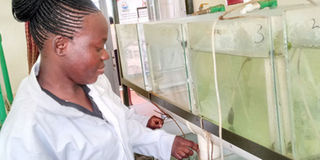Prime
How farmers can manage fish diseases

Catherine Agoye explains how she uses blackjack antigen to treat sick fish. PHOTO/LOMINDA AFEDRARU
What you need to know:
- Fish mortality has an enormous impact on the aquaculture industry by reducing fish production in the country.
- A cross-sectional study was recently carried out in Kajjansi a Kampala suburb, to evaluate potential risks of fish mortality and disease transmission and suitability of pond water for rearing fish.
Fish farming is becoming an increasingly important part of the food supply for the growing world population. Uganda is one of the countries in Africa where fish farming is on the rise, largely dominated by Nile tilapia and North Africa catfish.
Scientists in the fisheries sector say that fish diseases still are not a pressing issue for fish farming in Uganda and this may however be masked by other more prominent issues such as the need for quality feed and seed, as well as the low level of disease knowledge and awareness among farmers.
Innovations
However, although there is little challenge reported about fish disease in both fresh water and aquaculture fish, the burden of fish disease exists and scientists are inventing new innovations for treating the same.
As such scientists at the Aquaculture Research and Development Centre, Kajjansi, have developed an antigen from plants such as bidens pilosa (blackjack) to treat some diseases that attack fish.
Catherine Agoye, a research assistant at the institute identifies as Motile Aeromonas Septicaemia the common disease wiping out fish stocks from ponds. The disease is caused by Hydrophilia Aeromonas bacteria.
“Juvenile fish is more susceptible to Motile Aeromonas Septicaemia. Here the affected fish’s scales turn red besides losing gills,” says Agoye.
According to Agoye, the other diseases include tail rot and fin rot, bacterial gill disease also known as gill rot.
“In cages, symptoms such as fin rot, cloudy eyes and skin lesions have been reported indicating possibility of bacterial and fungal infections,” she says.
Treatment
Agoye and her team collected blackjack leaves from the wild and made extracts out of it.
They then tested the extract by mixing it with fish feed for the fish to feed directly to get the required doze.
After introducing the pathogen in fish species at the laboratory and observing the same, it proved to be working efficiently because the infected fish were seen healing perfectly.
This, therefore, indicates the extract from the blackjack can prevent fish from suffering from some diseases.
This study started in 2018 and will end June this year and the scientists are optimistic that it will be rolled out to aquaculture farmers facing the challenge of this disease.
Agoye and her team have processed the plant extract in both powder form which is mixed in the fish feed and in liquid form which is used for bathing the fish.
Application
Farmers are advised to cause a mixture of water and the liquid extract where they can pour fish fingerlings for a specific period of time before they are poured into the pond.
The scientists contend that the disease outbreak is as a result of farmers failing to adhere to best practices.
Farmers have been using un-recommended antibiotics for treating diseased fish.
Sometimes farmers tend to construct poor ponds and failing to keep the water quality which results to such disease burden.
Some basic biosecurity measures have been carried out in hatchers, but very few or no basic biosecurity measures are implemented routinely in grow-out farms.
There is still very little use of recommended antibiotics even though farmers do not use vaccination as a prophylactic strategy.
There is an indication that cases of aquatic diseases incidences leading to mortality rates of 60 percent have been reported in hatcheries and grow-out systems in Uganda.
Management
The scientists contend that farmers must adopt the common biosecurity measures in aquaculture.
Biosecurity and fish health management comprises a range of terms and procedures that are somewhat overlapping and coherent.
When put together they would constitute a holistic approach towards achieving a high level of biosecurity but in most cases not all components are included in biosecurity programmes a case in point is where vaccination seems not to be implemented as expected.
The scientists advise farmers to construct standard ponds where they can check upstream activities very well, keep clean quality water, stock quality fish fingerlings by quarantining them for 14 days for disease checks before stocking into the pond and avoid water pollutants.
Others include systematic and consistent routines for cleaning ponds followed by disinfection to reduce the general disease risk on a site.
Zoning by avoiding or reducing sharing input factors such as fish fingerlings, equipment, personnel and water resources to minimise disease transmission.
Removal and destruction of sick and dead fish will shed pathogens to the surroundings. Continuous removal and adequate destruction of ensilage of these fish contributes to reduce the overall infections pressure.
Fallowing through an operation where an aquatic establishment is emptied of aquatic animals susceptible to a disease of concern or known to be able to transfer the pathogenic agent.
Disease monitoring on health, productivity and environmental factors and the recording of these observations.
Disease surveillance through systematic series of investigations of a given population to detect and trace the occurrence of a disease for control purposes.
Feed additives that stimulate the immune system should be widely used in fish farming since it is low cost and easy to administer.
Vaccines are commercially available for many fish species against a range of diseases. Being a pharmaceutical product, vaccine efficacy and safety must be documented and vaccines licensed before marketing, which makes vaccination a practice most common in countries where fish farming has been industrialised.
Quality
Water quality is the most important limiting factor in rearing of fish and directly affects feed efficiency, growth rate, the fish’s health, and survival.
Aquatic life is highly dependent on physical, chemical, and biological factors of water, playing a substantial role in the biology and physiology of fish.




